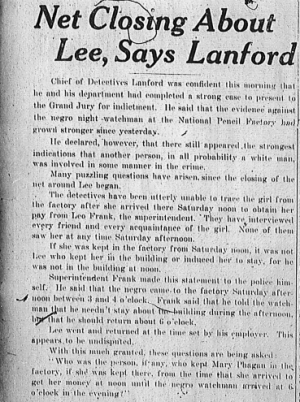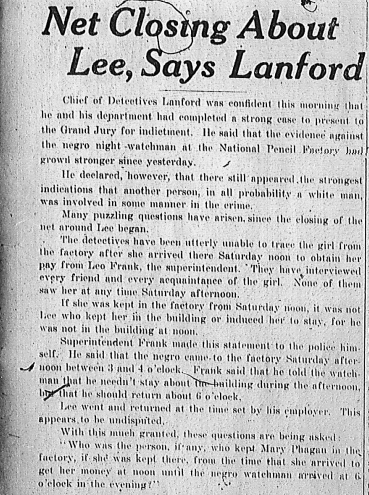 Another in our series of new transcriptions of contemporary articles on the Leo Frank case.
Another in our series of new transcriptions of contemporary articles on the Leo Frank case.
Atlanta Georgian
Wednesday, April 30th, 1913
Chief of Detectives Lanford was confident this morning that he and his department had completed a strong case to present to the Grand Jury for indictment. He said that the evidence against the negro night-watchman at the National Pencil Factory had grown stronger since yesterday.
He declared, however, that there still appeared the strongest indications that another person, in all probability a white man, was involved in some manner in the crime.
Many puzzling questions have arisen, since the closing of the net around Lee began.
The detectives have been utterly unable to trace the girl from the factory after she arrived there Saturday noon to obtain her pay from Leo Frank, the superintendent. They have interviewed every friend and every acquaintance of the girl. None of them saw her at any time Saturday afternoon.
If she was kept in the factory from Saturday noon, it was not Lee who kept her in the building or induced her to stay, for he was not in the building at noon.
Superintendent Frank made this statement to the police himself. He said that the negro came to the factory Saturday afternoon between 3 and 4 o’clock. Frank said that he told the watchman that he needn’t stay about the building during the afternoon, but that he should return about 6 o’clock.
Lee went and returned at the time set by his employer. This appears to be undisputed.
With this much granted, these questions are being asked:
“Who was the person, if any, who kept Mary Phagan in the factory, if she was kept there, from the time that she arrived to get her money at noon until the negro watchman arrived at 6 o’clock in the evening?”
Startling and Vital Questions.
“If Mary was not kept in the building by some one during these hours, by whom was she induced to enter the building later in the day or at night—surely not, by any stretch of the imagination, by the negro?”
“Is it reasonable to believe that the negro could have lured her into the building after darkness had fallen, or, in fact, that she would have been about the building alone at this time? What could have brought her here?”
“If the negro is guilty of the crime, is it not almost certain that some other person, probably a white man, was responsible for her presence in the building either a man who kept her there when she came for her pay or one who lured her there after Frank had gone to his home?”
“Where was Mary Phagan between 12 o’clock and 6 o’clock if the crime was committed after all the white men had left the building?”
It also is regarded by many as strange that the negro, as unintelligent as he may be, did not burn or otherwise destroy the blood-stained shirt which he is said to have worn the night of the crime. Instead, the detectives say that he threw it in a barrel where it was found as soon as they made a trip out there.
In spite of the declaration that there is evidence enough on hand to convict and hang the negro, the feeling persists that there are many things to clear up, if they have not already been cleared, by the detectives.
If the crime was committed between noon and shortly after 3 o’clock in the afternoon, the only persons in the building were Arthur White, Harry Denham and Leo Frank, according to the evidence.
Hours Still Unaccounted For
If the crime was committed between shortly after 3 o’clock and 6 o’clock at night, Frank was the only man in the building, known to the public, says the evidence so far produced. Is there another man to be found?
If the crime was committed at some time after 6 o’clock, where was Mary Phagan all this time between noon and 6 o’clock in the evening? That question must be answered if the mystery is to be cleared up.
The public says the case is not concluded. They have not been given enough evidence of such a convincing nature as to bring them to the belief that the negro is solely responsible for the brutal strangling of the Phagan girl.
It is admitted that some of the circumstances are damning. The old shirt found in a barrel in the negro’s home makes the case look very black for him. The notes seem to absolutely prove that he had a part in the tragedy—but convicting Newt Lee is far from clearing up the mystery, as the evidence stands to-day.
* * *
Atlanta Georgian, April 30th 1913, “Net Closing About Lee, Says Lanford,” Leo Frank case newspaper article series (Original PDF)
